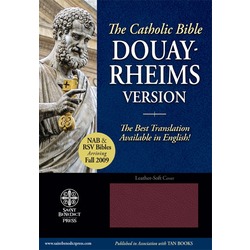Spotlight on the Douay-Rheims Bible
Jul 27, 2012 by Nick Rabiipour
 What is one of the oldest English Catholic Bibles still in wide circulation today? The Douay-Rheims Bible Translation. The Douay-Rheims Catholic Bible is the Catholic Bible that I have certainly learned the most about since I have worked for The Catholic Company. Before working for The Catholic Company I had never even heard of the Douay-Rheims Catholic Bible. One of my first days at The Catholic Company I remember touring around the warehouse and a copy of the Douay-Rheims caught my eye. I read a few verses and thought for a moment that it might be the Catholic version of the King James Bible. But through research and learning I have come to find out that there is much more to the Douay-Rheims then I thought.
What is one of the oldest English Catholic Bibles still in wide circulation today? The Douay-Rheims Bible Translation. The Douay-Rheims Catholic Bible is the Catholic Bible that I have certainly learned the most about since I have worked for The Catholic Company. Before working for The Catholic Company I had never even heard of the Douay-Rheims Catholic Bible. One of my first days at The Catholic Company I remember touring around the warehouse and a copy of the Douay-Rheims caught my eye. I read a few verses and thought for a moment that it might be the Catholic version of the King James Bible. But through research and learning I have come to find out that there is much more to the Douay-Rheims then I thought.
The History of the Douay-Rheims
The Douay-Rheims seems to be the only Catholic English translation of the Bible from the Latin Vulgate Bible still in active circulation. The Douay-Rheims (D-R) was translated by members of Douai, an English College, and the New Testament was published in Rheims in 1582. The Old Testament was published some 30 years later. The present D-R is a Bishop Challoner revision which took place between 1749-1752. The Douay-Rheims was THE Catholic Bible for hundreds of years until the mid-twentieth century when the Confraternity Bible was published.
The Case for the Douay-Rheims Bible
Today claim that the Douay-Rheims Bible is the Catholic Bible to read, study, and take as the authoritative translation. Those who make the argument that translating from the original Latin Vulgate is a better translation of the Catholic Bible than current translations from the original languages. Their argument tends to be as follows:
- The Latin Vulgate Bible was THE Bible of the Western Church for over a thousand years. In fact, Pope Pius XII stated in his encyclical letter Divino Afflante Spiritu, that the Vulgate is “free from any error whatsoever in matters of faith and morals.”
- The Vulgate is also supreme in that St. Jerome, who translated from the original languages to the Latin Vulgate in the 4th century, had a better understanding of the meaning of Greek and Hebrew words than we do many thousands of years later.
- St. Jerome also had older texts of the Catholic Bible in the original languages than we currently have today.
- According to some, these facts alone make a translation of the Bible from the Vulgate a better translation than from original texts which are younger than the ones St. Jerome used.
- Some further argue that the Douay-Rheims Bible leaves some passages obscure instead of doing what some modern Bible translations do, and that is add their interpretation in order to make a passage more readable.
Whether you agree or not with the case for the Douay-Rheims Bible, you can certainly see that the Douay-Rheims Bible is rich in history and linguistic beauty. Do you have a copy of the Douay-Rheims Bible? Why or why not?




